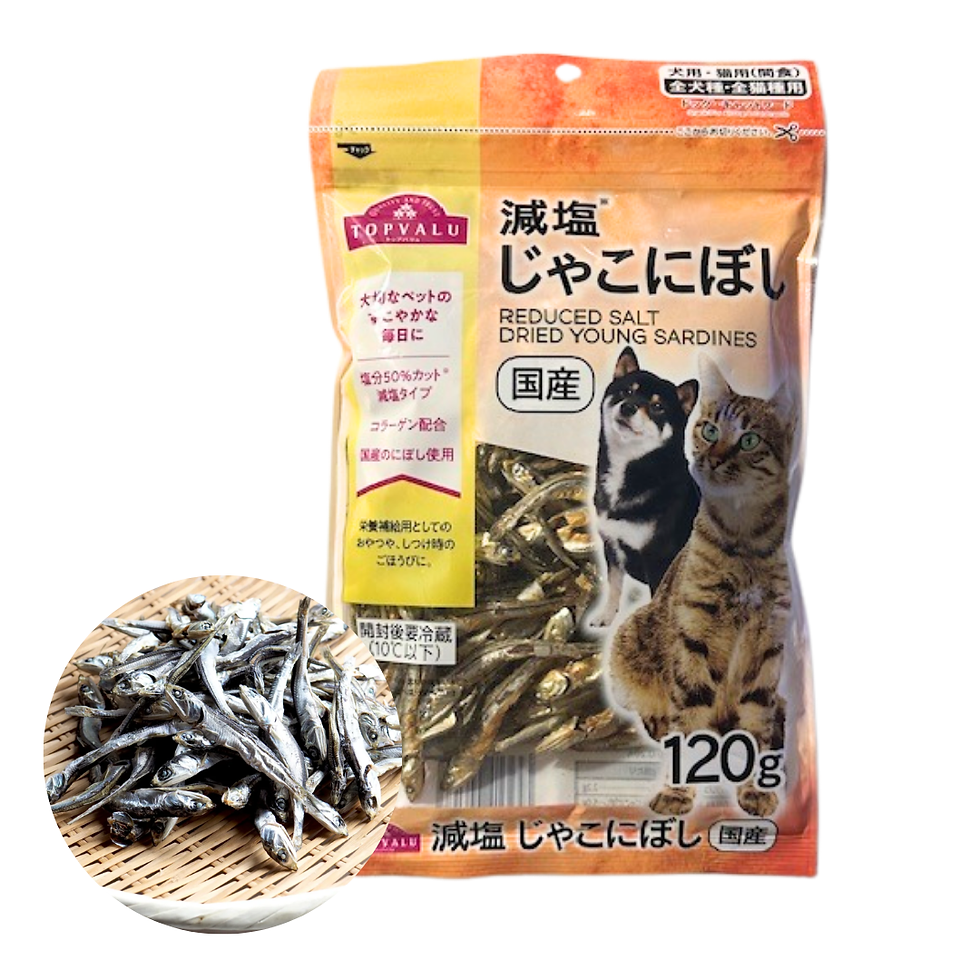Japanese-Made Pet Treats and the 10% rule
- Twin Tails
- Sep 8
- 3 min read
— A pet pro’s guide to safe, tasty, and easy-to-use choices
Treats power up everyday life with your dog or cat—rewards for good behavior, training reinforcers, or that extra nudge when appetite dips. Japanese-made treats are especially popular among pros for their traceable ingredients and careful manufacturing. Here’s a compact, owner-friendly guide to why they’re worth a look, plus how to choose and serve them wisely.

Why Japanese-made treats get the nod
Strong safety framework and clear labeling
Japan’s Pet Food Safety Act sets standards and labeling rules. Lots and contact info are typically listed, making traceability easier if issues arise.
Ingredient transparency
From chicken breast to venison/horse and ocean fish like bonito, sardine, and salmon, origin details are often available on packs or product pages.
Small-batch craftsmanship
Many makers use low-temp drying, air-drying, or oven-baking to preserve flavor and nutrients, and some publish third-party test results.
Shorter food miles
Faster from production to shelf helps preserve freshness—especially noticeable with fish aroma and meat flavor.
Label-reading that actually matters
What’s the first ingredient?
Aim for animal protein (meat or fish) up front. Ingredients are listed in order of amount.
Additives and flavorings
Limit synthetic preservatives, artificial colors, heavy flavoring, or strong sweeteners/humectants (e.g., excess glycerin). For fish treats, look for “unsalted/low-sodium.”
Nutrients and calories
Check crude protein, fat, fiber, ash, moisture, and metabolizable energy (kcal). Keep treats within 10% of daily calories.
Country of manufacture vs ingredient origin
“Country of origin” often means where the final processing occurred. Raw materials may be imported—check for ingredient origins or contact the maker if it matters to you.
Best-by date, lot, and storage
After opening, watch humidity and oxidation. Even with a zipper and desiccant, plan to finish quickly.
Quick guide by type
Type | What it is | Best for | How to use |
Freeze-dried (chicken, fish, liver) | Light, aromatic, long shelf life | Picky eaters, most cats | Crumble as topper or rehydrate to aid digestion |
Jerky (chicken breast, venison, horse) | Satisfying chew, easy to tear | Rewards/training | Choose pieces you can snap by hand; cut small for calorie control |
Air-dried/Baked | High palatability, nutrient-dense | Boosting meal interest | Dense often = higher calories; serve sparingly |
Fish treats (bonito, sardine, salmon) | Natural DHA/EPA, great aroma | Cats; coat care for dogs | Prefer unsalted/low-sodium; UTI-prone cats: ask your vet |
Dental chews | Chewing for stress relief | Dogs who love to gnaw | Size up (bigger than mouth opening), supervise, avoid very hard items |
Pastes/Paté | Easy to lick, high “reward value” | Seniors, puppies/kittens | Great for pills/hydration; watch portions |
Dogs vs. cats: key differences
Dogs
For training, think small, low-calorie, high-reward. Japanese fish treats and easy-tear jerkies shine here.
Cats
More meat-focused. Prioritize animal protein. Treats are extras—especially if your cat has urinary or kidney considerations, keep an eye on magnesium and phosphorus and consult your vet.
7 tips for safe, smart treating
Follow the 10% rule
Keep treats within 10% of daily calories (5% if weight control or health issues).
New proteins: start tiny
Chicken, beef, fish can trigger sensitivities. Watch skin, ears, and stools.
Match hardness to teeth and jaw strength
Seniors, small breeds, and young pets need gentler textures. Avoid bone or very hard chews that risk fractures.
Prevent gulping
Choose sizes larger than your pet’s mouth; discard small broken pieces; always supervise.
Pair with water
Dry treats can dehydrate—keep fresh water available.
Use it up quickly after opening
Aim for 1–2 weeks. Keep cool and dry; if the smell changes, stop.
Health history matters
Kidney, pancreas, and allergy-prone pets need extra label scrutiny—confirm with your vet.
Standout Japanese ingredients
Chicken breast: Lean, high-protein, versatile for all life stages.
Venison (game): Lean, iron-rich; useful in rotation for food sensitivities.
Horse: High-protein, very palatable; small amounts satisfy.
Bonito, sardine, salmon: Enticing aroma; choose boneless and unsalted/low-sodium.
Sweet potato, pumpkin (mostly for dogs): Gentle on digestion; fiber adds fullness. Keep plant-based treats minimal for cats.
FAQs
Q. Does “Made in Japan” mean no additives?
A. Not necessarily. “No added preservatives/colors” must be stated. Some small-batch, low-temp products don’t need preservatives, but always verify.
Q. Can dogs and cats share the same treats?
A. Single-ingredient meat/fish freeze-dried treats often work for both. Dog-only dental chews or sugary/strongly flavored products aren’t ideal for cats. Always check “intended species.”
Q. How often can I give treats?
A. Daily is fine within the 10% rule. On heavy training days, reduce the main meal to balance calories.
Final checklist before you buy
Animal protein listed first
Minimal unnecessary colors/flavors/sweeteners
Unsalted/low-sodium for fish treats
Nutrients and calories clearly labeled
Maker info, lot number, best-by date shown
Texture/size matches your pet’s teeth, age, and size
You can keep portions within the 10% rule
Bottom line: Japanese-made treats earn high marks for safety, traceability, and craftsmanship. With a keen eye on labels and portion control, you’ll turn treat time into a daily habit that supports both health and happiness. Try a few different proteins and textures to discover your pet’s new favorite.


Comments